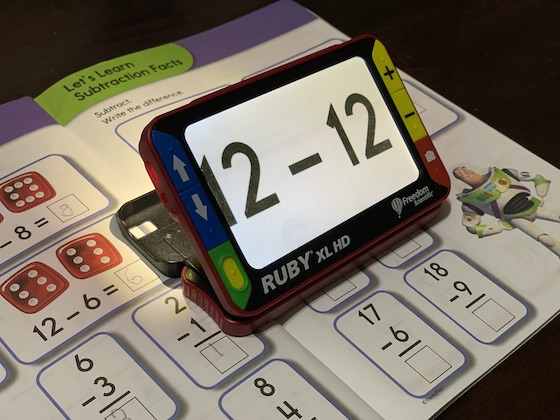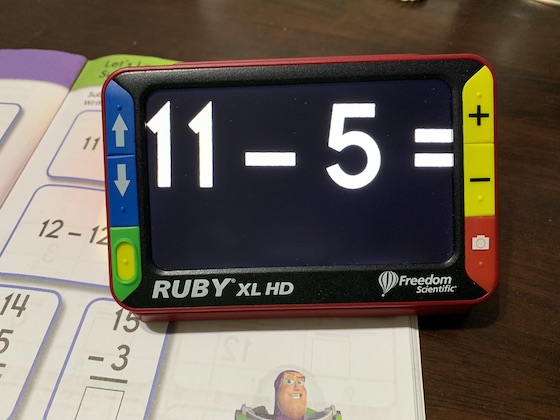I was talking with my daughter Natalia’s school teacher earlier today with regards to her performance in class. She mentioned that she was doing her school work very well and that her Ruby XL HD is an awesome assistant when it comes to helping her deal with schoolwork.

For those not familiar with low vision solutions would be wondering what exactly is a Ruby… it’s basically a handheld video magnifier produced by U.S-based company Freedom Scientific. The device itself uses a 5-megapixel camera located at the back of the device, and it comes with two very strong illuminating LEDs, making it easy to read words magnified on the 5-inch screen.
Natalia uses it mainly to read off her text/exercise books, and recently has taken into reading her piano books, which is interesting considering she learned to play the piano by ear instead. The Ruby comes with a built-in reading stand, as well as a foldaway handle. The handle itself maybe too large for a 6-year old, but the reading stand functions just as well.

Back again to the camera. It’s capable of 2x-14x zoom, and the Ruby users can use it to snap photos. Natalia normally uses it to snap words that she is unfamiliar with to show them to me afterwards. When displaying live video on the screen, users are able to zoom and even change contrast modes to something that they are comfortable with.
Some folks might say why not use an iPhone but it generally boils down to usability. The Ruby’s large buttons and decent HD camera makes it very easy to use and is purposeful as a low vision aid, even a child can use it. On the other hand, an iPhone is pretty much a smartphone first more than anything else (thus plenty of distractions to offer a kid), and the camera and flash are all off-centre.

While the Ruby is an all-round awesome device, there are some minor usability gripes though. While there’s a USB port, you can’t charge the rechargeable battery via USB, and instead must rely on the supplied charger and adapter. Battery life is rated at 3 hours, so in a classroom setting, Natalia has to be mindful to switch it off whenever she’s not using it.
Availability of low-vision aids are a concern at most places. In Singapore, SNEC’s Low Vision Service can advice on devices, but the better place to get an actual feel of the devices would be the Singapore Association of the Visually Handicapped’s (SAVH) Assistive Devices Centre, and boy…they really have a lot of devices on display to try out.
In Malaysia, the best (and perhaps the only route) to get low-vision aids such as the Ruby would be the Malaysian Association for the Blind (MAB). The MAB provides a service to order devices at subsidised prices and while they do not have devices on display, sometimes there may be orders that are yet to be collected, so you do get a chance to have a look at some of these gadgets.
Pricing wise, thanks to the MAB, we managed to get Natalia’s unit at slightly above RM 3,000 (~ USD 816), which is lower than the list price on Freedom Scientific’s website due to the OKU subsidies.
